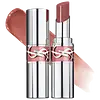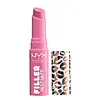What's inside
What's inside
 Key Ingredients
Key Ingredients

 Benefits
Benefits

 Concerns
Concerns

 Ingredients Side-by-side
Ingredients Side-by-side

Diisostearyl Malate
EmollientHydrogenated Polyisobutene
EmollientPhenyl Trimethicone
Skin ConditioningSynthetic Wax
AbrasiveC12-15 Alkyl Benzoate
AntimicrobialCetyl Dimethicone
EmollientOctyldodecanol
EmollientDiisopropyl Dimer Dilinoleate
EmollientPhytosteryl Macadamiate
Skin ConditioningPentaerythrityl Tetraethylhexanoate
EmollientEuphorbia Cerifera Cera Extract
Polyethylene
AbrasivePentaerythrityl Tetraisostearate
EmollientPolyglyceryl-2 Isostearate
EmulsifyingCI 77891
Cosmetic ColorantParaffin
PerfumingPassiflora Edulis Seed Oil
EmollientCera Microcristallina
Emulsion StabilisingHexadecene
SolventCI 77491
Cosmetic ColorantCI 77492
Cosmetic ColorantCI 77499
Cosmetic ColorantTocopheryl Acetate
AntioxidantCI 15850
Cosmetic ColorantPentaerythrityl Tetra-Di-T-Butyl Hydroxyhydrocinnamate
AntioxidantCaprylic/Capric Triglyceride
MaskingAluminum Hydroxide
EmollientSilica
AbrasiveTocopherol
AntioxidantFicus Carica Fruit Extract
HumectantParfum
MaskingDiisostearyl Malate, Hydrogenated Polyisobutene, Phenyl Trimethicone, Synthetic Wax, C12-15 Alkyl Benzoate, Cetyl Dimethicone, Octyldodecanol, Diisopropyl Dimer Dilinoleate, Phytosteryl Macadamiate, Pentaerythrityl Tetraethylhexanoate, Euphorbia Cerifera Cera Extract, Polyethylene, Pentaerythrityl Tetraisostearate, Polyglyceryl-2 Isostearate, CI 77891, Paraffin, Passiflora Edulis Seed Oil, Cera Microcristallina, Hexadecene, CI 77491, CI 77492, CI 77499, Tocopheryl Acetate, CI 15850, Pentaerythrityl Tetra-Di-T-Butyl Hydroxyhydrocinnamate, Caprylic/Capric Triglyceride, Aluminum Hydroxide, Silica, Tocopherol, Ficus Carica Fruit Extract, Parfum
Pentaerythrityl Tetraisostearate
EmollientPolybutene
Diisostearyl Malate
EmollientCaprylic/Capric Triglyceride
MaskingCandelilla Cera
EmollientRicinus Communis Seed Oil
MaskingOctyldodecanol
EmollientHydrogenated Polydecene
EmollientPolyglyceryl-3 Diisostearate
EmulsifyingBis-Diglyceryl Polyacyladipate-2
EmollientHydrogenated Coco-Glycerides
EmollientPolyethylene
AbrasiveEthylhexyl Palmitate
EmollientTocopheryl Acetate
AntioxidantCera Microcristallina
Emulsion StabilisingGlycine Soja Oil
EmollientZingiber Officinale Root Extract
MaskingMangifera Indica Seed Butter
Skin ConditioningPrunus Amygdalus Dulcis Oil
Skin ConditioningCitrus Limon Peel Oil
MaskingWater
Skin ConditioningGlucomannan
Skin ConditioningGlycerin
HumectantTrihydroxystearin
Skin ConditioningSodium Hyaluronate
HumectantVanillyl Butyl Ether
MaskingCI 77120
Cosmetic ColorantAlumina
AbrasiveAluminum Hydroxide
EmollientColophonium
Hydrogenated Vegetable Oil
EmollientCaprylyl Glycol
EmollientMenthol
MaskingMenthyl Lactate
MaskingEthylhexylglycerin
Skin ConditioningTocopherol
AntioxidantPentaerythrityl Tetra-Di-T-Butyl Hydroxyhydrocinnamate
AntioxidantPhenoxyethanol
PreservativeParfum
MaskingLimonene
PerfumingHydroxycitronellal
PerfumingCitral
PerfumingBenzyl Alcohol
PerfumingBenzyl Salicylate
PerfumingCI 15850
Cosmetic ColorantCI 45410
Cosmetic ColorantCI 77491
Cosmetic ColorantCI 77492
Cosmetic ColorantCI 77499
Cosmetic ColorantCI 77891
Cosmetic ColorantMica
Cosmetic ColorantCI 42090
Cosmetic ColorantPentaerythrityl Tetraisostearate, Polybutene, Diisostearyl Malate, Caprylic/Capric Triglyceride, Candelilla Cera, Ricinus Communis Seed Oil, Octyldodecanol, Hydrogenated Polydecene, Polyglyceryl-3 Diisostearate, Bis-Diglyceryl Polyacyladipate-2, Hydrogenated Coco-Glycerides, Polyethylene, Ethylhexyl Palmitate, Tocopheryl Acetate, Cera Microcristallina, Glycine Soja Oil, Zingiber Officinale Root Extract, Mangifera Indica Seed Butter, Prunus Amygdalus Dulcis Oil, Citrus Limon Peel Oil, Water, Glucomannan, Glycerin, Trihydroxystearin, Sodium Hyaluronate, Vanillyl Butyl Ether, CI 77120, Alumina, Aluminum Hydroxide, Colophonium, Hydrogenated Vegetable Oil, Caprylyl Glycol, Menthol, Menthyl Lactate, Ethylhexylglycerin, Tocopherol, Pentaerythrityl Tetra-Di-T-Butyl Hydroxyhydrocinnamate, Phenoxyethanol, Parfum, Limonene, Hydroxycitronellal, Citral, Benzyl Alcohol, Benzyl Salicylate, CI 15850, CI 45410, CI 77491, CI 77492, CI 77499, CI 77891, Mica, CI 42090
Ingredients Explained
These ingredients are found in both products.
Ingredients higher up in an ingredient list are typically present in a larger amount.
Aluminum Hydroxide is a form of aluminum. It can be naturally found in nature as the mineral gibbsite. In cosmetics, Aluminum Hydroxide is used as a colorant, pH adjuster, and absorbent.
As a colorant, Aluminum Hydroxide may add opacity, or reduce the transparency. Aluminum hydroxide is contains both basic and acidic properties.
According to manufacturers, this ingredient is an emollient and humectant. This means it helps hydrate the skin.
In medicine, this ingredient is used to help relieve heartburn and help heal ulcers.
There is currently no credible scientific evidence linking aluminum hydroxide in cosmetics to increased cancer risk.
Major health organizations allow the use of aluminum hydroxide in personal care products and have not flagged it as a carcinogenic risk at typical usage levels.
Learn more about Aluminum HydroxideThis ingredient is an emollient, solvent, and texture enhancer. It is considered a skin-softener by helping the skin prevent moisture loss.
It helps thicken a product's formula and makes it easier to spread by dissolving clumping compounds.
Caprylic Triglyceride is made by combining glycerin with coconut oil, forming a clear liquid.
While there is an assumption Caprylic Triglyceride can clog pores due to it being derived from coconut oil, there is no research supporting this.
Learn more about Caprylic/Capric TriglycerideCera Microcristallina isn't fungal acne safe.
Ci 15850 is the pigment color red. It is an azo dye and created synthetically.
Azo dyes need to be thoroughly purified before use. This allows them to be more stable and longer-lasting.
This ingredient is common in foundations, lipsticks, and blushes. This color is described as brown/orangey red.
It has many secondary names such as Red 6 and Red 7. According to a manufacturer, Red 6 usually contains aluminum.
Learn more about CI 15850Ci 77491 is also hydrated iron III oxide. It's sole purpose is to give a red/pink hue to products.
Iron III oxides are classified as inorganic chemicals for coloring.
Synthetically created Ci 77491 is considered safer than those naturally found. This is because the synthetically created version may contain less impurities. Iron oxides are generally non-toxic and non-allergenic.
Learn more about CI 77491Ci 77492 is also hydrated iron III oxide. It's sole purpose is to give a yellow hue to products.
Iron III oxides are classified as inorganic chemicals for coloring.
Synthetically created Ci 77492 is considered safer than those naturally found. This is because the synthetically created version may contain less impurities. Iron oxides are generally non-toxic and non-allergenic.
Learn more about CI 77492Ci 77499 is also hydrated iron III oxide. It is created from mixing red and black iron oxides. This helps give shades of darkness to a product.
Iron III oxides are classified as inorganic chemicals for coloring.
Ci 77891 is a white pigment from Titanium dioxide. It is naturally found in minerals such as rutile and ilmenite.
It's main function is to add a white color to cosmetics. It can also be mixed with other colors to create different shades.
Ci 77891 is commonly found in sunscreens due to its ability to block UV rays.
Learn more about CI 77891Diisostearyl Malate is an emollient and most often used in lip products. It comes from isostearyl alcohol, a fatty acid, and malic acid, an AHA.
As an emollient, Diisostearyl Malate helps create a thin film on your skin to trap moisture in. This helps keep your skin soft and smooth.
Octyldodecanol is a fatty alcohol. It is primarily used to enhance the texture of products.
As an emulsifier, Octyldodecanol helps prevent the oils and waters from separating. It also prevents ingredients from creating foam when shaken.
Octyldodecanol is created by reducing fatty acid to an alcohol.
Due to its high molecular weight, it does not get absorbed into the skin.
Learn more about OctyldodecanolParfum is a catch-all term for an ingredient or more that is used to give a scent to products.
Also called "fragrance", this ingredient can be a blend of hundreds of chemicals or plant oils. This means every product with "fragrance" or "parfum" in the ingredients list is a different mixture.
For instance, Habanolide is a proprietary trade name for a specific aroma chemical. When used as a fragrance ingredient in cosmetics, most aroma chemicals fall under the broad labeling category of “FRAGRANCE” or “PARFUM” according to EU and US regulations.
The term 'parfum' or 'fragrance' is not regulated in many countries. In many cases, it is up to the brand to define this term.
For instance, many brands choose to label themselves as "fragrance-free" because they are not using synthetic fragrances. However, their products may still contain ingredients such as essential oils that are considered a fragrance by INCI standards.
One example is Calendula flower extract. Calendula is an essential oil that still imparts a scent or 'fragrance'.
Depending on the blend, the ingredients in the mixture can cause allergies and sensitivities on the skin. Some ingredients that are known EU allergens include linalool and citronellol.
Parfum can also be used to mask or cover an unpleasant scent.
The bottom line is: not all fragrances/parfum/ingredients are created equally. If you are worried about fragrances, we recommend taking a closer look at an ingredient. And of course, we always recommend speaking with a professional.
Learn more about ParfumPentaerythrityl Tetra-Di-T-Butyl Hydroxyhydrocinnamate (long name, huh?) is a synthetic antioxidant.
It is used to help stabilize other antioxidants or prevent the color from changing in a product.
As an antioxidant, it helps fight free-radical molecules. Free-radical molecules are capable of damaging our cells and other genetic material. Thus, antioxidants may reduce the signs of aging.
This ingredient is oil-soluble.
Learn more about Pentaerythrityl Tetra-Di-T-Butyl HydroxyhydrocinnamatePentaerythrityl Tetraisostearate is derived from isostearic acid. It is an emollient and emulsifier.
The highest concentration of this ingredient is found in lipsticks.
This ingredient is minimally water soluble and may not be Malassezia folliculitis, or fungal-acne safe.
Learn more about Pentaerythrityl TetraisostearatePolyethylene is a synthetic ingredient that helps the skin retain moisture. It is a polymer.
It is also typically used within product formulations to help bind solid ingredients together and thicken oil-based ingredients. When added to balms and emulsions, it helps increase the melting point temperature.
Tocopherol (also known as Vitamin E) is a common antioxidant used to help protect the skin from free-radicals and strengthen the skin barrier. It's also fat soluble - this means our skin is great at absorbing it.
Vitamin E also helps keep your natural skin lipids healthy. Your lipid skin barrier naturally consists of lipids, ceramides, and fatty acids. Vitamin E offers extra protection for your skin’s lipid barrier, keeping your skin healthy and nourished.
Another benefit is a bit of UV protection. Vitamin E helps reduce the damage caused by UVB rays. (It should not replace your sunscreen). Combining it with Vitamin C can decrease sunburned cells and hyperpigmentation after UV exposure.
You might have noticed Vitamin E + C often paired together. This is because it is great at stabilizing Vitamin C. Using the two together helps increase the effectiveness of both ingredients.
There are often claims that Vitamin E can reduce/prevent scarring, but these claims haven't been confirmed by scientific research.
Learn more about TocopherolTocopheryl Acetate is AKA Vitamin E. It is an antioxidant and protects your skin from free radicals. Free radicals damage the skin by breaking down collagen.
One study found using Tocopheryl Acetate with Vitamin C decreased the number of sunburned cells.
Tocopheryl Acetate is commonly found in both skincare and dietary supplements.
Learn more about Tocopheryl Acetate